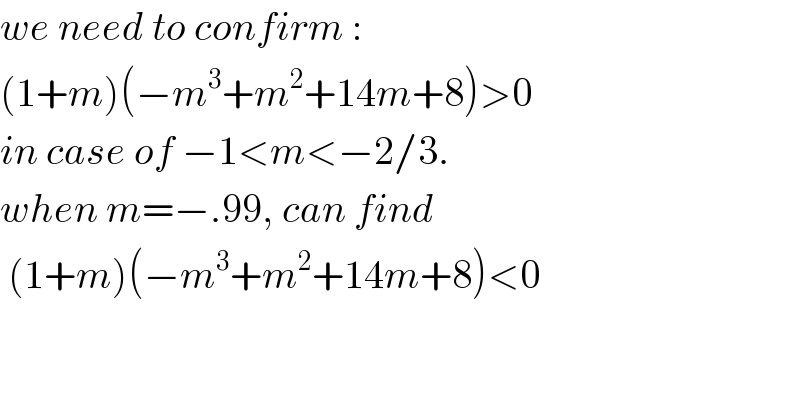
Question and Answers Forum
Question Number 108914 by 1549442205PVT last updated on 21/Aug/20
![Q108815(19/8/20)(unanswer)by 1x.x Given f(x)=(1/( (√(1+x))))+(1/( (√(1+a))))+((√(ax))/( (√(ax+8)))) x,a∈R;x,a>0.Prove that 1<f(x)<2 Solution:Put x=tan^2 A,a=tan^2 B(A,B∈[0,(π/2)) f(x)=cosA+cosB+((tanAtanB)/( (√(tan^2 Atan^2 B+8)))) =cosA+cosB+((sinAsinB)/( (√(8cos^2 Acos^2 B+sin^2 Asin^2 B)))) Put cosA=z,cosB=y(z,y∈(0,1])we have f=z+y+((√((1−z^2 )(1−y^2 )))/( (√(8z^2 y^2 +(1−z^2 )(1−y^2 ))))) =z+y+((√((1−z^2 )(1−y^2 )))/( (√(9z^2 y^2 +1−(z^2 +y^2 ))))) i)First we prove f(x)>1 ⇔z+y+((√((1−z^2 )(1− y^2 )))/( (√(9z^2 y^2 +1−(z^2 +y^2 )))))>1(1) If z+y≥1 then the inequality(1) is true.Consider z+y<1.Put m=1−(z+y)⇔z+y=1−m(0<m≤1) z^2 +y^2 =(z+y)^2 −2zy=(1−m)^2 −2zy (1)⇔(((1−z^2 )(1−y^2 ))/( 9z^2 y^2 +1−(z^2 +y^2 )))>[1−(z+y)]^2 ⇔1+z^2 y^2 −(z^2 +y^2 )>[9z^2 y^2 +1−(z^2 +y^2 )]m^2 1+z^2 y^2 −[1−2m+m^2 −2zy]>[9z^2 y^2 +1−(1−2m+m^2 −2zy)]m^2 ⇔z^2 y^2 +2zy+2m−m^2 >(9z^2 y^2 +2zy+2m−m^2 )m^2 ⇔m^4 −m^2 (9z^2 y^2 +2zy+2m)+(z^2 y^2 +2zy+2m−m^2 )>0 We look at LHS as a quadratic polynomial with respect to ♮im^2 ε defined on the interval(0;1) and we denote by P(m).By the theorem above the sign of quadratic poly.P(m)>0⇔ Δ_P =(9z^2 y^2 +2zy+2m)^2 −4(z^2 y^2 +2zy+2m−m^2 )<0 ⇔81z^4 y^4 +4z^2 y^2 +4m^2 +36z^3 y^3 +36mz^2 y^2 +8mzy−4(z^2 y^2 +2zy+2m−m^2 )<0 ⇔81z^4 y^4 +36z^3 y^3 +36mz^2 y^2 +8(m−1)zy+8m^2 −8m<0 ⇔8m^2 +(36z^2 y^2 +8zy−8)m+81z^4 y^4 +36z^3 y^3 −8zy<0(3) We look at LHS (3) like as a quadratic polynomial w.r.t ♮mε and denote by Q(m) We has Q(0)=81(zy)^4 +36(zy)^3 −8zy ≤81t/64+36t/16−8t=225t/64−8t<0 (due to 0< t=zy≤1/4 ) Q(1)=1+36(zy)^2 +8zy−8+81(zy)^4 +36(zy)^3 −8zy =−7+36(zy)^2 +81(zy)^4 +36(zy)^3 ≤ −7+36/16+81/256+36/64<0 (due to zy≤1/4) By the convert theorem above the sign of the quadratic polynomial we infer Q(m)>0 ∀m∈(0;1)which means P(m) has Δ_P <0 ∀m∈(0;1)⇒the inequality (1) proved ii)Now we prove that f(x)<2 ⇔z+y+((√((1−z^2 )(1−y^2 )))/( (√(9z^2 y^2 +1−(z^2 +y^2 )))))<2(4) ⇔(((1−z^2 )(1−y^2 ))/(9z^2 y^2 +1−(z^2 +y^2 )))<[2−(z+y)]^2 ⇔1+z^2 y^2 −(z^2 +y^2 )<[9z^2 y^2 +1−(z^2 +y^2 )](1+m)^2 (note (1−m=z+y like as above we have −1≤m=1−(z+y)<1 as 0<z+y≤2(∗)) ⇔z^2 y^2 +2zy+2m−m^2 <(9z^2 y^2 +2zy+2m−m^2 )(1+2m+m^2 ) ⇔z^2 y^2 +2zy+2m−m^2 <(9z^2 y^2 +2zy+2m−m^2 )+(9z^2 y^2 +2zy)(2m+m^2 )−m^4 +4m^2 >0 ⇔−m^4 +4m^2 +(9z^2 y^2 +2zy)(2m+m^2 )+8z^2 y^2 >0 ⇔(9m^2 +18m+8)(zy)^2 +2(m^2 +2m)zy−m^4 +4m^2 >0(4) We look at LHS like as a quadratic polynomial w.r.t ♮zyε and denote by H(t)(set t=zy,0<zy≤(((z+y)/2))≤1) a)The case 9m^2 +18m+8>0 We consider the discriminant Δ_H ′of H(t) Δ_H ′=(m^2 +2m)^2 +(9m^2 +18m+8)(m^4 −4m^2 ) =m^4 +4m^3 +4m^2 +9m^6 +18m^5 −28m^4 −72m^3 −32m^2 =9m^6 +18m^5 −27m^4 −68m^3 −28m^2 =m^2 (9m^4 +18m^3 −27m^2 −68m−28) <0( due to ∣m∣≤1). Therefore,we infer H(t)>0∀t∈(0;1]which means the inequality (4)is proved ,so f(x)<2 b)The case 9m^2 +18m+8 < 0 ⇔−1<m<−2/3 .We have { ((H(0)=−m^4 +4m^2 =m^2 (4−m^2 )>0 )),((H(1)=−m^4 +15m^2 +22m+8=)),(((1+m)(−m^3 +m^2 +14m+8)>0)) :} By the convert theorem above the sign of the quadratic polynomial we infer H(t)>0 ∀t=zy∈(0;1)⇒(4)is proved which means we ger f(2)<2 other way: Similar to the case i)Rewrite H(t) in the form H(m^2 )as the quadratic poly. w.r.t ♮m^2 ε with the highest efficient k=(−1)we get H(0)>0,H(1)>0 ⇒kH(0)<0,kH(1)<0⇒H(m)>0 ∀m^2 ∈[0,1]⇔m∈[−1,1] From i)and ii)we obtain 1<f(x)<2(q.e.d)](Q108914.png)
Commented by1549442205PVT last updated on 21/Aug/20

Commented by1xx last updated on 24/Aug/20
![f(x)=(1/( (√(1+x))))+(1/( (√(1+a))))+((√(ax))/( (√(ax+8)))) x>0 , a>0 prove:1<f(x)<2 f^′ (x)=−((1/2))(1/((1+x)(√(1+x))))+(−(1/2))(1/((1+(8/(ax)))(√(1+(8/(ax))))))(8/a)(−(1/x^2 )) f^′ (x)=0⇒(x^2 −(8/a))[x^2 +(8/a)(3−(8/a))x+(8/a)]=0 ∵x>0 ∴x_1 =(√(8/a)) △=[8/a(3−8/a)]^2 −4(8/a)≥0⇒a≤2 f^′ (x)=0⇒ { ((f^′ (x_1 =(√(8/a)))=0 a≥2)),((f^′ (x_1 =(√(8/a)))=f^′ (x_(2,3) )=0 a<2)) :} case A: a≥2 f(x_1 =(√(8/a)))=(2/( (√(1+(√(8/a))))))+(1/( (√(1+a)))) lim_(x→0,∞) f(x)=1+(1/( (√(1+a)))) ∵a≥2 ∴(2/( (√(1+(√(8/a))))))>1 ∴ f_(max) =f(x_1 =(√(8/a))) f(x)>lim_(x→0,∞) f(x)=1+(1/( (√(1+a))))>1 f(x_1 =(√(8/a)))≷2 (2/( (√(1+(√(8/a))))))+(1/( (√(1+a))))≷2 let t=(√(1+(√(8/a)))) then a=(8/((t^2 −1)^2 )) (2/( (√(1+(√(8/a))))))+(1/( (√(1+a))))≷2 ⇔(((t^2 −1)^2 )/((t^2 −1)^2 +8))≷4∙(((t−1)^2 )/t^2 ) ⇔0≷3t^4 −2t^3 −9t^2 +36 ⇔0≷2(t−1)t^3 +(t^2 −6)^2 +3t^2 ∵t>1 ∴(2/( (√(1+(√(8/a))))))+(1/( (√(1+a))))<2 ∴f(x)≤f_(max) =f(x_1 =(√(8/a)))<2 ∵f(x)>lim_(x→0,∞) f(x)=1+(1/( (√(1+a))))>1 ∴ 1<f(x)<2 case B: 0<a<2 f^′ (x_(2,3) )=0 ⇒ x_(2,3) ^2 +(8/a)(3−(8/a))x_(2,3) +(8/a)=0 ⇒x_2 x_3 =(8/a) ∵x_1 =(√(8/a)) ∴x_2 <x_1 <x_3 x_(2,3) ^2 +(8/a)(3−(8/a))x_(2,3) +(8/a)=0 let p=x_(2,3) (ap)^2 +8(3a−8)p+8a=0 ⇒ (ap+8)(ap+a)=(8+a)(ap)+8(8−3a)p ⇒ a(ap+8)(p+1)=(a^2 −16a+64)p ⇒ (1/(1+p))∙((ap)/(ap+8))=(a^2 /((8−a)^2 )) ⇒ (1/( (√(1+x_(2,3) ))))∙((√(ax_(2,3) ))/( (√(ax_(2,3) +8))))=(a/(8−a)) due to 0<a<2 let m=(1/( (√(1+x_(2,3) )))) and n=((√(ax_(2,3) ))/( (√(ax_(2,3) +8)))) then { ((((1/m^2 )−1)((1/n^2 )−1)=(8/a))),((mn=(a/(8−a)))) :} ⇒ (m+n)^2 =1+mn=(8/(8−a)) ⇒ m+n=(√(8/(8−a))) f(x_(2,3) )≷f(x_1 ) ⇔( m+n)≷(2/( (√(1+(√(8/a)))))) ⇔ (√(8/(8−a)))≷(2/( (√(1+(√(8/a)))))) ⇔ ((√8)/( (√(((√8)−(√a))((√8)+(√a))))))≷((2(√(√a)))/( (√(((√8)+(√a)))))) ⇔ (√8)≷(√(4(√a)∙((√8)−(√a)))) ⇔ ((√2))^2 ≷2(√2)(√a)−((√a))^2 ⇔ ((√a)−(√2))^2 ≷0 ∵((√a)−(√2))^2 >0 ∴ f(x_(2,3) )>f(x_1 ) f_(max) =max{f(x_2 ),f(x_3 )}≷2 ⇔( m+n+(1/( (√(1+a)))))≷2 ⇔ (1/2)((√(8/(8−a)))+(1/( (√(1+a)))))≷1 ∵ (1/2)((√(8/(8−a)))+(1/( (√(1+a)))))≤(√((1/2)((8/(8−a)))+(1/(1+a)))) ∴ f_(max) =max{f(x_2 ),f(x_3 )}≷2 ⇔ (√((1/2)((8/(8−a)))+(1/(1+a))))≷1 ⇔ 0≷a(7−2a) ∵ 0<a<2 ∴ 0<a(7−2a) ∴ f_(max) =max{f(x_2 ),f(x_3 )}<2 if f(x_1 )>lim_(x→0,∞) f(x)=1+(1/( (√(1+a))))>1 then 1<f(x)<2 else f_(min) =f(x_1 ) f_(min) =f(x_1 )≷1 ⇔ (2/( (√(1+(√(8/a))))))≷(1−(1/( (√(1+a))))) make Rt△ ((1/( (√(1+a)))))^2 +(((√a)/( (√(1+a)))))^2 =1^2 ∴ ((√a)/( (√(1+a))))>1−(1/( (√(1+a)))) think of (2/( (√(1+(√(8/a))))))≷((√a)/( (√(1+a)))) ⇔ 3a−(√8)(√a)+4≷0 ⇔ 2a+((√a))^2 −2(√2)(√a)+((√2))^2 +2≷0 ⇔ 2a+((√a)−(√2))^2 +2≷0 ∵ a>0 ∴ 2a+((√a)−(√2))^2 +2>0 therefore (2/( (√(1+(√(8/a))))))>((√a)/( (√(1+a))))>1−(1/( (√(1+a)))) f_(min) =f(x_1 )>1 so in case B, 1<f(x)<2 Q.E.D](Q109104.png)
Commented by1xx last updated on 21/Aug/20

Commented by1xx last updated on 21/Aug/20

Answered by 1xx last updated on 20/Aug/20

Commented by1549442205PVT last updated on 20/Aug/20

Commented by1xx last updated on 20/Aug/20

Commented by1xx last updated on 20/Aug/20

Commented by1xx last updated on 20/Aug/20

Commented by1549442205PVT last updated on 21/Aug/20

